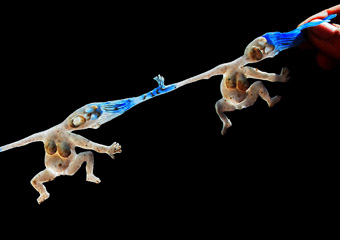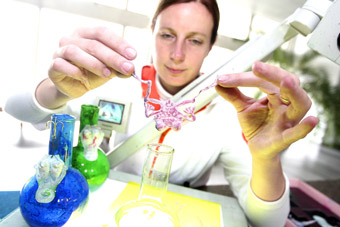revisioning east/west
fiona winning: IETM plenary, vilnius

Mrs Strangled and Mr Shot, Psilicone Theatre
photos courtesy of the artists
Mrs Strangled and Mr Shot, Psilicone Theatre
VILNIUS: EUROPEAN CAPITAL OF CULTURE 2009. VILNIUS: THE CAPITAL OF LITHUANIA. LITHUANIA: INDEPENDENT SINCE 1990. RIDING THROUGH THE STREETS CHECKING OUT THE SOVIET MODERNIST AND CONTEMPORARY ARCHITECTURES WITH MEDIA ARTIST AND RACONTEUR GEDIMINAS URBONAS WAS A GREAT INTRODUCTION TO THE LAYERS OF HISTORY IN THIS CITY.
Lost Vilnius Through the Window of a Trolleybus introduced us to brutalist concrete buildings, to timber summer houses from another era, to the KGB prison-now-museum and the soon to be demolished historic Lietuva cinema—one of many buildings lost to the growing property market. Exposing us to the redevelopment of many culturally significant buildings brought about by the privatisation of public spaces, the trip critically charted the remapping of the city since the Soviets left in 1990.
An ‘artistic trip’ developed for the participants of the IETM Autumn Plenary Meeting in October last year, this experience was a fitting introduction to the contradictions raised by two decades of integration of East and West Europe—the broad theme of the meeting.
We return to the cobblestone streets and baroque architecture of the old city, wet with the rain that’s apparently typical. Our colleagues explain that the etymology of Lithuania (or as the locals say, “Lietuva”) derives from “lietus”—rain. The inside-out yellow umbrella logo of the event we’re attending suddenly makes sense.
Six Australian delegates attend the IETM meeting in Vilnius. Formally known as the Informal European Theatre Meeting, in recent years this 30-year-old network is reaching out to include other parts of the world. Renamed IETM: International Network for Contemporary Performing Arts, it’s a membership-based organisation with more than 400 members in 45 countries. It holds two plenary meetings per year, hosted by different cities and attended by an eclectic network of artists, producers, presenters and academics.
The Australia Council is an Associate Member of the IETM, and has been sending delegations of Australian producers and artists to their meetings since 2008. A partnership between the two organisations has now been formalised with the appointment of David Pledger (director of Melbourne’s not yet its difficult) as Project Director, IETM-Australia Council for the Arts Collaboration Project. Based at the IETM office in Brussels, Pledger describes his work as, “developing more opportunities for Australian artists to work internationally…and taking an active role in larger discussions which support more international artists working and performing within the EU.” One of his first tasks was to attend the IETM Plenary in Vilnius along with John Baylis (Performing Lines), Michelle Kotevski (Urban Theatre Projects), Lockie McDonald (Fullsky), Kate Neylon (pvi collective) and myself.
The IETM plenaries are about professional connection and exchange. ‘Pitching’ is fiercely discouraged; IETM is vehemently not an arts market. The panels and discussions typically address artform development, models of making and presentation, and sharing knowledge and strategies across borders. The performance program introduces delegates to some local work. And the informal moments are about developing relationships, brokering international collaborations and partnerships, sharing anecdotes and, in Vilnius, quite a lot of vodka.
The plenary was hosted by Menu Spaustuve, a performing arts centre located in a recently refurbished printing house in the middle of the old city—so recently they were still finishing the wiring and painting the day before the plenary opened. I arrived early to encounter great excitement—“The heating has arrived!” With its range of multi-use spaces, black box theatre and outdoor marquee, Menu Spaustuve was a great location for the events and for hosting the various constellations of people emerging in intense discussion.
The plenary focused on the shift in relationships between Eastern and Western Europe over the last two decades—examining promises and expectations from both sides—and the emergence of new colonisations. The impact of more fluid contact since the wall/curtain came down was a major area of discussion, proving to be full of contradictions and questions. Have the geographic and ideological been replaced with economic differences? How can resources be shared more equally across borders? Have Western markets ‘lost interest’ in the East? Why?
Nele Hertling, the founding director of Berlin’s Hebbel Theatre observed that while there are a handful of Eastern directors who’ve become ‘shooting stars’ in the Western European theatre festival circuit, presenters, press and audiences have generally shown disdain for the ‘folkloric’, ‘old fashioned’ work emerging from the East. She maintains the West’s interest in the East was stronger during the Cold War: “… whenever artistic work from behind the Wall was presented, one could be sure of interested audiences and press attendance. Maybe the interest was not so much in the artistic, but in the ‘subversive’ quality…When this was gone, the dream of artists—having an easy and open dialogue with new Western audiences—was cruelly damaged. Without that subversive quality the audience lost interest.”
Maciej Nowalk, Director of the Polish Theater Institute, maintained that although “we became much more open about new ideas and possibilities…the iron curtain still exists…with all of the money and power coming from the West…The UK has most of Poland’s plumbers and our artists too because they can earn more there…and Polish artists who stay ‘give in’ to the West by creating work that caters to the ‘old world’ curiosity.” Explaining that this drain of artists and ideas to the West has not been replaced with an influx of collaborations with western artists, he finishes simply “The exchange is uneven.”
As an outsider to the East/West European experience, these (and many other) insights were useful to decode and contextualise some of the artform discussions and performance work on offer.
Staged concurrently was the International Theatre Festival Sirenos, which, along with the Lithuanian Dance Information Centre offered delegates the opportunity to see performances with local audiences. With little knowledge of the artists and companies in the program, many delegates took a series of blind punts on shows we booked before arriving. And like any festival some of the works were great and others were not. Collectively though, they represented a strong survey of Lithuania’s rich theatre tradition (including works by internationally renowned directors Oskaras Korsunovas and RimasTuminas), its relatively young contemporary dance practice (for the five Soviet decades only classical ballet and folk dance received state support) and a new generation of hybrid collaborations.

Aukse Petruliene, Mrs Strangled and Mr Shot, Psilicone Theatre
courtesy the artist
Aukse Petruliene, Mrs Strangled and Mr Shot, Psilicone Theatre
My highlight was the modest but distinctive DIY show Mrs Strangled and Mr Shot made by young performance company Psilikono Teatras, a collaboration between visual artist Aukse Petruliene and musician Tomas Dobrovolskis. Petruliene animates a series of hand-made miniature silicone puppets and props on a worktable in front of the audience. Projected onto a large screen, these constantly mutating images create a compelling world of grotesque desire and intrigue. Building atmosphere and narrative, Dobrovolskis’ one-man orchestra provides the live soundtrack. Together, the two depict a story loosely based on documentary material from a scandalous pre-war murder case reinterpreted into a mythological exploration of hunger and desire.
As both technicians and performers, the collaborators play with their hand-made materials/instruments and the live pacing of the storytelling with enormous pleasure, creating an engrossing experience for the audience. Watching these artists, I’m sure they’re part of a new generation doing what they love to do, without needing to second guess what the West might want.
Three days of lively discussion, performances and meeting new and old friends and colleagues made the IETM Autumn Plenary a fantastic, albeit whirlwind, experience. For an Australian it was a window on another world, where the idea of East/West has a different set of co-ordinates, cultural meanings and lived experiences. Being my first time in Lithuania and at an IETM, I was glad to have gone a couple of days early to see the extraordinary Urban Stories: The X Baltic Triennial of International Art at the Contemporary Arts Centre and to visit the new National Gallery and the KGB Museum. It helped me understand where I was and to physically and culturally acclimatise to (some of) the differences.
As many delegates reiterated in different ways throughout the meeting, cooperation and partnership need continuity to thrive. While this is true of the relationships between East and West in Europe, it’s also true of Australia’s involvement in this international arena. So here’s hoping future Australian delegates take up the opportunity to attend IETM Meetings and take the time to broker new networks and collaborations over the next decade—in both Europes.
IETM (International Network for Contemporary Performing Arts) Autumn Plenary, Vilnius, Lithuania, Oct 8-11, 2009, www.ietm.org
The Australia Council has negotiated a special flat rate of 295 Euros for Australian artists and arts organisations interested in joining the IETM. The council supports an Australian presence at the 2010 IETM Spring (April 15-18) and Autumn (October/November) plenary meetings. David Pledger, Project Director, IETM-Australia Council for the Arts Collaboration Project, is based at IETM’s head office in Brussels (david.pledger@ietm.org).
RealTime issue #95 Feb-March 2010 pg. 10






